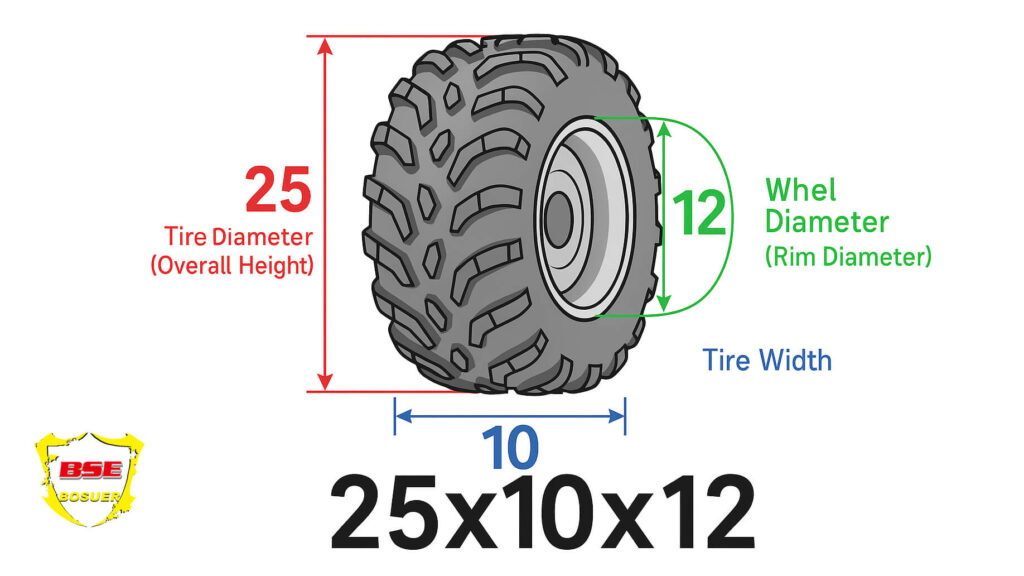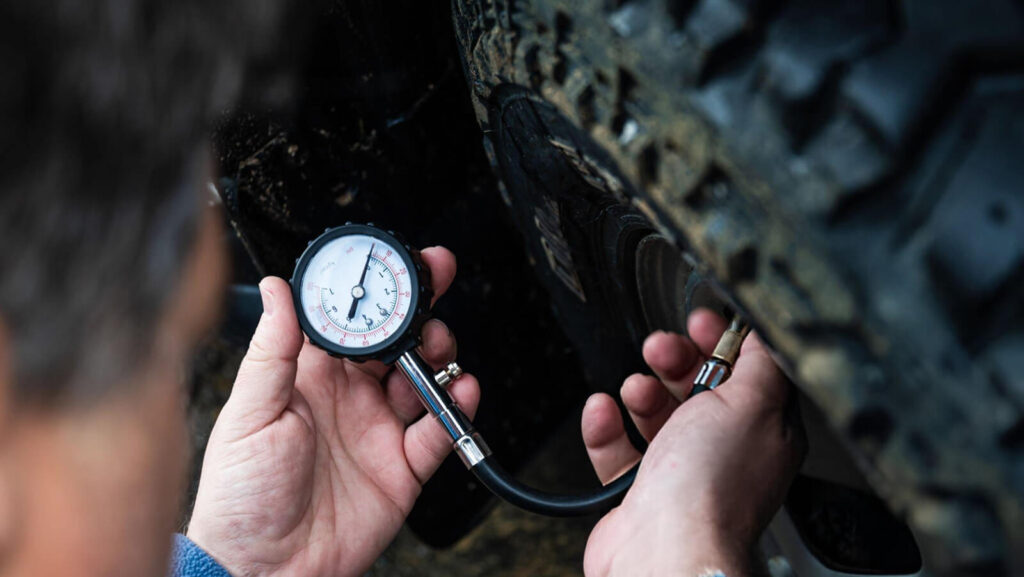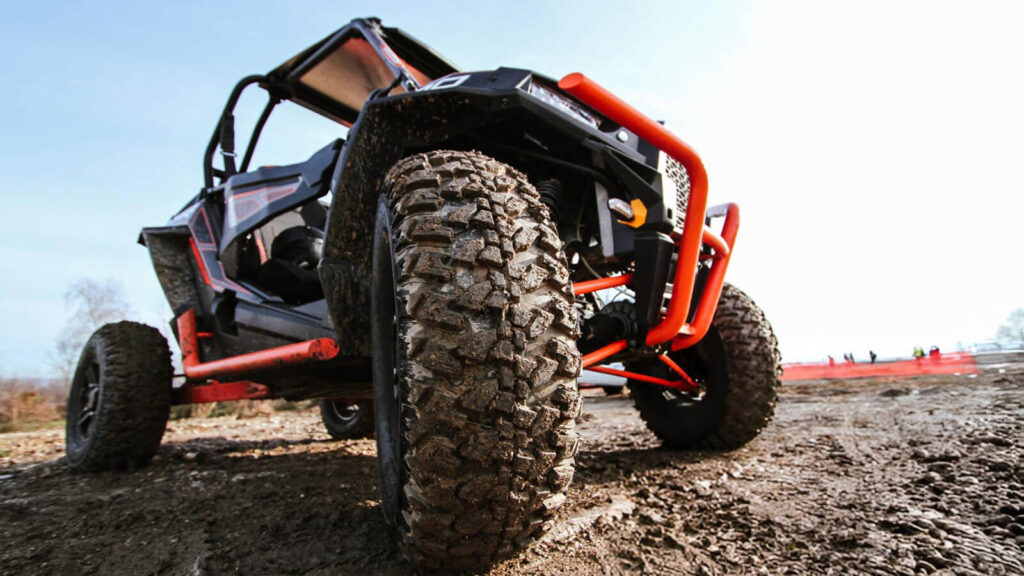Comprendre la taille des pneus de VTT peut sembler complexe au premier abord pour les conducteurs inexpérimentés. Mais en tant que conducteur de VTT, il est également important de comprendre le fonctionnement des dimensions. Cependant, maîtriser cette compétence est essentiel pour tout conducteur de VTT, comme les dimensions 25x10x12 ; elles seront beaucoup plus faciles à comprendre. Vous obtiendrez des informations essentielles sur votre pneu, comme sa hauteur, sa largeur et son diamètre de jante. Lire les chiffres vous aidera à choisir des pneus qui améliorent la sécurité et les performances, vous garantissant ainsi une conduite précise et optimale.
Table des matières
BasculerPourquoi il est important de comprendre la taille des pneus de votre VTT
La taille des pneus influence directement de nombreux facteurs de performance, notamment la garde au sol, la géométrie de la suspension, la tenue de route et le freinage. Les problèmes directs liés à des pneus mal montés sont nombreux. Bien que les pneus plus grands soient courants, ils peuvent frotter contre les garde-boue lors de la compression de la suspension, endommageant ainsi les pneus et les composants environnants. Un mauvais dimensionnement peut réduire la capacité de braquage et entraîner une direction lourde. L'un des principaux risques liés à l'utilisation d'une jante mal dimensionnée est le détalonnage, c'est-à-dire le décrochage du pneu pendant la conduite, entraînant une perte totale de contrôle. Pour éviter ce problème potentiel, suivez toujours les recommandations du fabricant ou consultez des tableaux de montage fiables pour VTT.

Que signifient les numéros de pneus de VTT ?
Il n'y a que trois chiffres à retenir concernant les dimensions des pneus de VTT : la hauteur, la largeur et le diamètre de la jante. Vous pouvez trouver toutes les autres dimensions à l'aide de ces chiffres clés. Par exemple, pour un pneu 25x10x12, 25 correspond à la hauteur, 10 à la largeur et une jante de 12 pouces est requise. Cette spécification est assez courante pour la plupart des VTT. Savoir lire ces chiffres vous aidera à choisir des pneus adaptés à votre véhicule et offrant les performances dont vous avez besoin.
Hauteur des pneus (premier chiffre) : Pourquoi cette hauteur est-elle si importante pour votre VTT ?
Dans la taille 25x10x12, le premier chiffre (25) indique la hauteur du pneu lorsqu'il est entièrement gonflé à vide. Cette hauteur est importante car elle influence la qualité de votre VTT Ils permettent de franchir des obstacles tels que des rochers ou des ornières profondes. Des pneus plus gros améliorent le franchissement des obstacles, mais peuvent réduire les performances à basse vitesse et solliciter davantage le moteur et la transmission. Si vous installez des pneus plus gros sans avoir préalablement réglé votre VTT, vous risquez d'endommager des composants clés ou de les user plus rapidement. Par conséquent, avant d'envisager une taille supérieure, analysez l'impact sur les autres composants de votre système VTT.
RecommandationPour un usage commercial ou utilitaire, évaluez les exigences de jeu ainsi que la tolérance de couple. Par exemple, des pneus de 27 pouces de diamètre peuvent nécessiter un changement de vitesse s'ils sont associés à des moteurs de faible cylindrée.
Largeur des pneus (deuxième chiffre) : Pourquoi la largeur des pneus est-elle un facteur si critique pour vos aventures hors route ?
Le deuxième chiffre, comme 10, représente la largeur mesurée d'un flanc à l'autre. Des pneus plus larges (10 à 11 pouces) offrent une meilleure adhérence et vous permettent de flotter sur les terrains meubles comme le sable ou la boue. Des pneus plus étroits (7 à 8 pouces) s'adaptent aux terrains durs comme la terre battue ou le gravier avec plus de précision. Faites votre choix en fonction du terrain que vous empruntez habituellement.
RecommandationChoisissez la largeur en fonction du terrain prévu et de la stabilité latérale requise. Évitez les augmentations de largeur qui compromettent le dégagement des ailes ou la géométrie de la direction. Des pneus plus larges augmentent généralement la surface de contact de 15 à 25 µm (1 TP3T), ce qui peut être avantageux pour les applications portantes sur terrain meuble.
Diamètre de la jante (troisième chiffre) : pourquoi ce chiffre est-il si crucial pour un ajustement correct ?
Le dernier numéro, 12, Indique la taille de jante adaptée au pneu. Un pneu de 12 pouces ne fonctionnera pas sur une jante de 10 pouces. Ils peuvent sembler similaires, mais ils ne sont absolument pas interchangeables. Vous devez adapter le diamètre de la jante au diamètre de la roue. Essayer de forcer peut entraîner le détachement du pneu lors de la conduite sur des surfaces dangereuses. Vérifiez toujours la compatibilité pneu-jante avant d'acheter.
Recommandation: Utilisez des jantes de dimensions compatibles avec celles des constructeurs pour garantir la sécurité, la facilité d'entretien et la standardisation des pièces sur l'ensemble des flottes. Avant de lancer un approvisionnement à grande échelle, vérifiez la compatibilité de toutes les unités de la flotte afin d'éviter tout problème de compatibilité.

Autres marquages importants sur les pneus de VTT
Les pneus VTT incluent également d’autres détails importants au-delà de la hauteur, de la largeur et de la taille de la jante.
Indice de pli
L'indice de plis mesure la résistance d'un pneu. À l'origine, il faisait référence au nombre de couches de tissu composant le pneu. Aujourd'hui, il indique la robustesse d'un pneu.
● 2 à 4 plisPlus légers et plus souples, ces pneus sont idéaux pour la conduite décontractée et les terrains peu accidentés.
● 6 à 8 plisPlus robustes, plus épais et mieux adaptés aux VTT de travail et aux terrains rocailleux ou accidentés. Ils résistent aux coupures et aux perforations, mais peuvent être plus rigides.
Pour les sentiers accidentés ou le transport, un indice de plis plus élevé aide à prévenir les crevaisons et augmente la durabilité.
Motif de bande de roulement
Le dessin de la bande de roulement influence l'adhérence de votre pneu sur différentes surfaces. Voici les quatre types les plus courants :
● Noueux:Crampons larges et espacés pour la boue profonde et les terrains meubles.
● Tout-terrain (AT):Convient à la plupart des surfaces. Ces pneus sont conçus pour offrir des performances équilibrées sur sentiers, gravier et boue légère.
● Sport/Course:Ils sont dotés de boutons plats et rapprochés qui permettent des virages rapides et contrôlés sur des pistes damées.
● Utilitaire/Travaux:Crampons profonds et robustes pour la traction lors du transport ou du labour.
Le choix d'une sculpture de bande de roulement adaptée au terrain d'utilisation est crucial. La conception de la bande de roulement influence directement la traction, la stabilité en virage et l'usure. Pour les flottes commerciales ou les véhicules utilitaires, la constance des performances sur terrains variables doit guider le choix. Une sculpture inadaptée réduit la traction et augmente l'usure.
L'indice de charge est l'un des éléments les plus importants. Ce n'est qu'un chiffre, mais il indique le poids que le pneu peut supporter en toute sécurité lorsqu'il est correctement gonflé. Juste à côté, vous pouvez voir un indice de vitesse, généralement représenté par une lettre. Cette lettre indique la vitesse maximale que le pneu peut supporter en toute sécurité lors d'une utilisation prolongée.
Certains pneus sont également dotés d'une flèche directionnelle. Cette petite flèche indique le sens de rotation du pneu une fois monté. C'est particulièrement important pour les pneus dotés d'une bande de roulement spéciale, notamment ceux conçus pour évacuer l'eau ou la boue sous le pneu afin de maintenir une bonne adhérence.
Il y a ensuite le marquage DOT. Il ressemble à un code court, mais il contient beaucoup d'informations. Il indique le lieu de fabrication du pneu, sa taille et sa date de fabrication.
Vous verrez également la pression maximale des pneus. Ce chiffre représente la pression d'air maximale que vous devriez gonfler. Un gonflage excessif au-delà de cette valeur peut être risqué.
Enfin, si vous voyez l'inscription NHS sur le pneu, cela signifie « Non destiné à la circulation sur autoroute ». Autrement dit, le pneu est conçu exclusivement pour la conduite tout-terrain. Il n'est pas adapté à la vitesse sur autoroute ni aux conditions routières.

Tableau des tailles de pneus de VTT et référence rapide
Pour choisir le bon pneu, consultez le tableau ci-dessous. Il indique les tailles courantes de pneus de VTT, ainsi que leur hauteur, leur largeur, leur diamètre de jante et leurs applications courantes. Avant de changer vos pneus, tenez toujours compte du dégagement de votre VTT, de la configuration de la transmission et du type de terrain sur lequel vous roulez.
Utilisez le tableau ci-dessous pour trouver le pneu idéal. Il répertorie les tailles courantes de pneus de VTT, leur hauteur, leur largeur, leur diamètre de jante et leur utilisation recommandée. Avant de remplacer vos pneus, renseignez-vous toujours sur le dégagement de votre VTT, la configuration de la transmission et le type de terrain sur lequel vous roulez.
| La taille des pneus | Hauteur | Largeur | Taille de la jante | Application commune |
| 22x7x10 | 22 pouces | 7 pouces | 10 pouces | Quads sportifs, randonnées légères (avant) |
| 24x8x12 | 24 pouces | 8 pouces | 12 pouces | Sentier général, polyvalent (avant) |
| 25x10x12 | 25 pouces | 10 pouces | 12 pouces | Tout-terrain, utilitaire (arrière) |
| 26x9x14 | 26 in | 9 pouces | 14 pouces | Conduite utilitaire, dégagement supplémentaire |
| 27x12x12 | 27 pouces | 12 pouces | 12 pouces | Utilisation intensive et agressive dans la boue |
Puis-je mettre des pneus plus gros sur mon VTT et quelles en sont les conséquences ?
Oui, mais attention. Des pneus plus gros ajoutent du poids. Cela sollicite le moteur, la suspension et la transmission. Vous pourriez constater un démarrage plus lent. Les pièces peuvent s'user plus vite. Des pneus plus hauts élèvent le centre de gravité de votre VTT, le rendant plus susceptible de basculer. Les virages sont moins stables. Des pneus surdimensionnés peuvent frotter contre les garde-boue. Un kit de surélévation pourrait être nécessaire pour résoudre ce problème. De plus, certaines garanties ne couvrent pas les dommages causés par les modifications de pneus. Prenez donc le temps d'évaluer l'impact avant de changer la taille de vos pneus.
Les tailles de pneus 25x10x12 et 25x8x12 sont-elles vraiment différentes ou sont-elles interchangeables ?
Non, ce n'est pas le cas. Les deux pneus mesurent 25 pouces de haut et sont compatibles avec une jante de 12 pouces. Leur largeur est toutefois différente. Le 25x10x12 est plus large. Il offre une meilleure adhérence dans la boue ou le sable. Cependant, il peut paraître lourd et plus difficile à diriger. Le 25x8x12 est plus fin. Il tourne plus facilement et mieux sur sol dur. Les variations de largeur affectent la maniabilité et peuvent également abîmer les pièces au fil du temps. Selon un rapport de la Consumer Product Safety Commission (CPSC), environ 7,4% de blessures et de décès liés aux VTT impliquaient des changements sur le marché secondaire, y compris les pneus.
Conclusion
Comprendre les dimensions des pneus de VTT peut sembler complexe au premier abord. Cependant, une fois les mesures comprises, tout devient simple. Le premier chiffre représente la hauteur, le deuxième la largeur et le dernier la taille de la jante. En combinant ces chiffres avec l'indice de pli et la sculpture de la bande de roulement, vous obtenez un profil complet des capacités d'un pneu. Choisir la bonne taille améliore le confort de conduite, l'adhérence, la sécurité, ou les trois à la fois. Un mauvais montage peut entraîner une usure excessive de votre VTT et augmenter les coûts d'entretien. Pour obtenir les meilleurs résultats, suivez toujours les recommandations du fabricant, vérifiez les marquages des pneus et réfléchissez à leur utilisation. En cas de doute sur le choix d'un pneu adapté à votre VTT ou à son usage, faites appel à un spécialiste ou consultez un tableau de pneus détaillé. Installer des pneus aux dimensions appropriées améliore la maniabilité et améliore les performances, ce qui inspire confiance à tous les niveaux.
